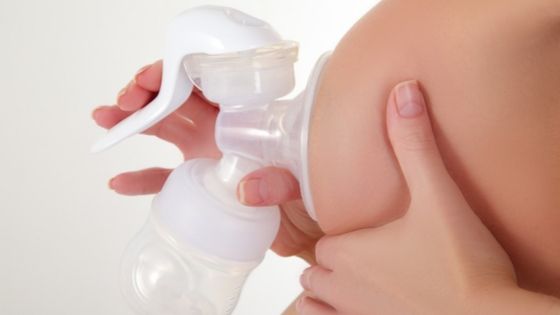Are you feeling confused about when to start pumping now that you have established breastfeeding?
Navigating the waters of a breastfeeding and pumping schedule can be tricky.
I remember wondering what was the best breastfeeding and pumping schedule for me? And were breastfeeding and pumping the same when it came to building and maintaining a supply?
Choosing to feed your baby breast milk is a wonderful gift.
Both the American Academy of Pediatrics and The World Health Organization recommend that babies be exclusively breastfed for the first 6 months of life.
If feeding your baby breast milk exclusively for this time period is possible for you, it is a worthy commitment.
Exclusive breastfeeding does not mean baby is exclusively nursing at the breast.
Pumping and feeding baby a bottle of breastmilk still gives baby all of the amazing benefits breastmilk has to offer.
What?s more, even if you are supplementing with formula, any amount of breastmilk that your baby gets is truly liquid gold, so whatever you can supply is worth it!
Today let?s talk all about the right breastfeeding and pumping schedule for you and look at sample schedules so that you can meet your breastfeeding goals.
Is Breastfeeding and Pumping the same?
Breastfeeding and pumping are not the same thing.
Usually, when we talk about breastfeeding, it is the act of latching baby to your breast and nursing them.
Pumping on the other hand, is the act of extracting breastmilk from your breast with a pump to feed to baby via a bottle, syringe, cup, or other method.
However, the term ?exclusive breastfeeding? (as is recommended by WHO and AAP) is more of an umbrella term.
This refers to nursing your baby at the breast and feeding them breastmilk from a bottle. This term means you are only feeding baby breastmilk, but it may be given to them in a variety of ways.
Supplementing is a term that is used when mamas are feeding their babies a combination of breastmilk and formula.
When to start pumping?
It is difficult to give an exact time to start pumping. This is because different mamas and families have different needs.
Some mothers may need to introduce pumping sooner because they have a short maternity leave and need to start stockpiling milk, baby is in the NICU, there is an anatomical reason (in baby or mother) causing breastfeeding challenges, or baby is not gaining weight.
However, whenever possible, it is best to wait to start pumping until breastfeeding is going well. Ideally, you want to have a good latch and signs of a well-established supply.
This means that baby is gaining weight well, has good diaper output, and breastfeeding is no longer painful. Typically, this occurs between 4-8 weeks postpartum.
General advice is that if things are going well– the longer you can wait to pump, the better for your supply and breastfeeding success.
Waiting until breastfeeding is well-established to introduce pumping is beneficial because the breast pump simply cannot imitate the sucking of a baby.
Introducing a pump too soon can make it difficult for some mamas to increase their supply to meet baby?s growing demands.
Additionally, breast pumps aren?t as effective at removing milk as babies. This can alter the supply and demand principle that tells your body to produce breastmilk, and can result in frustrating clogged ducts. (source)
Breastfeeding and pumping schedule
Assuming that breastfeeding is going well for you and baby, you can start to introduce pumping between 4-8 weeks postpartum.
This will give you time to build up a small stash before going back to work or when you need to be away from baby.
If you are home with baby for maternity leave and can nurse baby at the breast on demand, Lactation Consultants usually recommend that you continue to nurse on demand but introduce one pumping session at the same time each day.
This will help your body learn to produce for the pump and recognize the need for milk at that time. Many mamas pick in the morning right after feeding baby.
Read on for more detailed descriptions of breastfeeding and pumping schedules, exclusive pumping schedules, and sample breastfeeding and pumping schedules for a variety of scenarios.
Exclusive pumping schedules
Exclusive pumping is when nursing mothers are unable to nurse their babies at the breast.
These mothers, instead of formula feeding, choose to still feed their babies breastmilk that they extract via pumping.
This might be due to separation from baby due to health reasons, baby?s inability to latch, or a variety of other personal reasons.
Exclusive pumping is a decision that mamas don?t take lightly.
It is a huge time commitment and takes a lot of determination and perseverance.
But these mamas know the benefit of breastmilk and still want to exclusively feed their babies breastmilk for as long as possible.
Sadly, many mamas are told that exclusive pumping will never work and can?t find the support necessary to make it a success.
However, exclusive pumping is totally possible.
One of the most important things (aside from your determination!) is going to be high-quality double electric pump. Many exclusive pumping mamas (known as EPers) rent hospital-grade pumps because they are more effective at extracting milk.
Newborn exclusive pumping schedule:
If you are starting exclusive pumping from birth it essential that you begin pumping within 6 hours of baby being born.
From there, you want to mimic a newborn feeding schedule as best as possible. That means pumping 8-10 times in a 24-hour period.
According to KellyMom, 10 pumping sessions are optimal for building up and maintaining an exclusive pumping supply.
These sessions do not need to be evenly spaced, but you should avoid going longer than 4-5 hours without pumping. By 7-10 days postpartum you want to be pumping 25-27 oz per day. This is a sign that exclusive pumping and supply is doing well.
If your daily amount is lower than this, you can discuss prescriptions and herbs that may help increase your supply. You can even focus on your diet to eat more milk supply increasing foods.
Do not get discouraged if you are below this supply marker.
Keep at your exclusive pumping, some mama?s supplies take a bit longer to build and increase and will see success by 9-12 weeks postpartum.
When exclusively pumping, aim to pump for 20-30 minutes per pumping session. Other advice is to continue pumping for a few minutes after the last drop of milk falls.

Exclusive pumping schedule with older babies:
In the first 12 weeks of exclusive pumping you are really building up a supply which is why pumping should happen round the clock.
Once you?ve established a supply, and assuming exclusive pumping is going well by 3 months, the rest of baby?s first year of exclusive pumping will not be quite as intense and you can gradually drop your number of pumps while still maintaining supply (source).
According to Amanda from Exclusive Pumping, most exclusive pumpers aim to pump for 120 minutes per day as a general guideline.
To create the right pumping schedule for you, and keeping the average pumping sessions recommended for each age range below in mind, you can divide 120 by the number of pumping sessions to see how long to pump for.
Exclusive pumping schedule at 3 months:
Between 3-6 months, you can decrease your number of sessions per day to 6-8 pumping sessions.
This might look like: 6am, 10am, 12pm, 3pm, 6pm, 10pm
Exclusive pumping schedule at 6 months:
Between 6-9 months you can decrease your number of pumping sessions to 5-6 per day. This schedule would look similar to the 3-6-month schedule, but you might cut out the 6pm pumping time.
Exclusive pumping schedule at 9 months:
Between 9-12 months, you can decrease to 4 pumping sessions per day. Keep in mind that during this time frame baby will be eating far more solids and probably won?t need as much breastmilk per day.
This might look like: 6am, 10am, 2pm, 10pm
Exclusive pumping schedule at 12 months and beyond
This will depend a lot on how much breastmilk your baby is drinking, your interest in introducing cow?s milk or another milk source, and what your breastfeeding goals are. Many exclusive pumping mamas decrease to 1-3 pumping sessions per day at 12+ months.
This might look like: 6am, 12pm, 10pm or 6am, 6pm
Mamas that are breastfeeding and pumping
Mamas that are not exclusively pumping, but have the need to be away from their baby for long periods of time due to work or other obligations will need to pump to maintain their supply while away from their baby.
Additionally, pumping while away from baby is breastmilk you can store for baby to drink from a bottle while you are apart.
Mamas that breastfeed and pump will have huge variations in their schedules and pumping needs. This is because different mamas need to be away for different lengths of time. For this reason, it?s hard to give set breastfeeding and pumping schedules at each age.
Reasons to pump while breastfeeding:
1.Moms get a break: Even if you are a stay at home or work at home mama, pumping will allow you to be away from baby to get a break, and will let others help out with feeding
2.Increase milk supply: In some cases, adding in pumping with your breastfeeding an really help build up a low milk supply (see a sample of this below). You can try these pumping tips on how to increase milk supply.
3.To build a stash: It?s important for all breastfeeding mothers to have somewhat of a freezer stash, even if it?s small. In the event of an emergency you?ll want to have breastmilk on hand!
4.Return to work: Perhaps the most common reason for pumping, you?ll want to prepare for your return to work by having milk stored and ready for baby while you are apart
Sample breastfeeding and pumping schedule
For Newborns:
Earlier in the article we established that waiting to introduce pumping as long as possible is best for establishing supply and a strong breastfeeding relationship.
This means waiting to introduce pumping until you are 4-8 weeks postpartum and seeing signs of a good nursing relationship.
If you are planning to go back to work, you will need to build up a small stockpile for baby on your first day of work. Aim to start pumping 2-3 weeks before your return to work (source).
Really, you only need to have enough milk for the amount of time you?ll be away (~3 oz every 2-3 hours), because while you?re away you?ll replace that for the next day.
However, most mamas want a bit more of a stockpile just in case of emergency.
To start out pumping while breastfeeding your newborn:
Add one pumping session to your day at the same time every day
Try to pump 30-60 minutes after your baby last nursed, or estimate about an hour before you next expect them to nurse
Breasts are naturally fuller early in the day, so pumping 30-60 minutes after your baby?s first morning nursing session is a great starting place
To really ramp up your stockpile/freezer stash in the week before returning to work, you can pump 2-4 times per day.
Breastfeeding and pumping schedule for older babies
Once your baby is older, and you are regularly away from baby and used to pumping, you should aim to pump at roughly the same time that baby eats while you are away, or however many sessions you need to pump while you?re away from baby to match what they are consuming.
Ideally, you want to pump at the same times each day to help you body know to make milk at that specific time. Keeping regular intervals to your pumping is also helpful.
Take a look at the sample schedules below.
For more support with this, I highly recommend the Milkology Back to Work Pumping Class, she covers everything you need to know to navigate pumping at work.
A sample schedule for breastfeeding and pumping at work
If you have a traditional 9am-5pm job, here is a sample schedule that includes breastfeeding and pumping:
6am – Breastfeed (or whenever your baby wakes)
8am – Breastfeed at drop-off (or whatever time you part from baby for the day)
10am – Pump
1pm – Pump
4pm – Pump
5:30 – Breastfeed (or whenever you pick-up/see baby)
Breastfeed on demand until bedtime and through the night
*If possible or desired, you may want to go to your baby?s daycare or home to baby and their caregiver during your lunch break to breastfeed before their nap

A sample schedule for breastfeeding and pumping to increase milk supply
To use your pump to help build your supply while you are breastfeeding, you want to aim to pump for 10-15 minutes after every breastfeeding session.
If this feels impossible, you may choose to pump only after daytime feedings, or after 4 key feedings throughout the day (6am, 10am, 2pm, 6pm).
You can also try what?s known as ?power pumping?. You can do this 1-3 times per day, for 3 days in a row to help increase your supply alongside breastfeeding:
Pump 20 minutes on both sides
Rest 10 minutes
Pump 10 minutes on both sides
Rest 10 minutes
Pump 10 minutes on both sides (this is a total of 1 hour of pumping)
Breastfeeding and pumping schedules unpacked
Now you should be feeling far more confident in your journey into exclusive pumping, or figuring out when and how to introduce pumping alongside breastfeeding.
We?d love to hear your experience or any questions, please chime in below!












